Anya Davidson is an artist, musician and cartoonist residing in Chicago. Her first graphic novel School Spirits was published in 2013 by the now defunct publisher Picturebox. She’s been busy since the release of this first graphic novel with shows, art and working on a new serialized comic strip called Band for Life, the tale of a noise rock band in Chicago, their woes and issues as they try to make their music career work. A collection of her serialized comics Band for Life has recently been released by Fantagraphics. I’ve had the chance to discuss with Anya about Band for Life, her career in comics, her first graphic novel School Spirits, music and colour in her work.
—
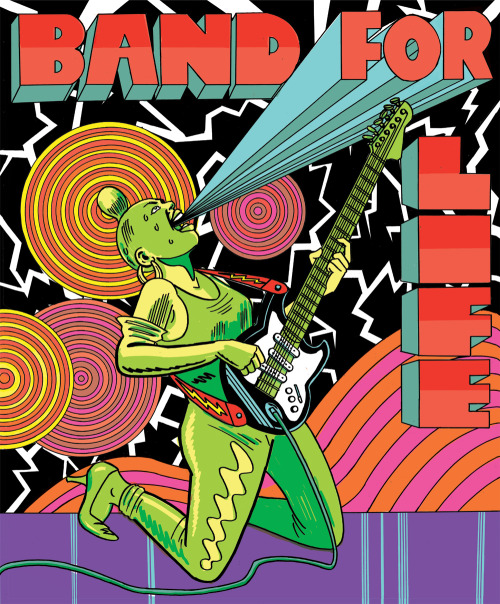
Anya Davidson: My work isn’t about any one particular thing, but I do think that the unifying factor is it deals with leftist political and progressive politics within character-driven stories. I think a lot of my work has a political aspect. It’s really personal, but it’s also really lefty. I’m trying not to make it too didactic; I don’t want to be preachy. I’m not interested in that at all.
PL: When looking at your previous work, and in particular School Spirits, you can see that there is a recurring theme of anti-conformity, of a rebellion against the massive systems your characters are in, whether it’s school or office work or factory work. How do you see your work?
AD: I’m not sure. It’s impossible for me as the artist to say for sure. One of the things that I struggle with, or at least that frustrates me, is that I don’t have an objective idea of myself. None of us can, really. Diane Arbus, and I’m not quoting her directly, said something like “people who seem the most eccentric are the ones whose view of themselves differs the most from how the outside world views who they are.” I’m not sure I know, but I like hearing how other people perceive the work.
PL: I first encountered your work in the anthology Believed Behavior back in 2013 for which you did a fantastic story about factory workers and their broken dreams.
AD: I really like Andy Rench, the publisher of that newspaper anthology, and his work. He’s really good at finding ways to showcase cartoonists and he’s really active in Chicago. The story was only two pages, but it was a lot of fun to make. If anybody hasn’t seen that anthology they should look it up. Then they should look into the work of the artist from that anthology and see what these artists like and what else they’ve done.
I think it’s interesting that people, whether it’s in music or comics, have this impulse once they find something they like, to do research and figure out who influenced that artist or author and just keep digging deeper to figure out the movement or history of where this comes from. There’s a great drive in those that like comics to understand where the work they like is coming from, to research and educate themselves about the things they like and I find that great, it’s what makes being a creative person exciting.
PL: Is there anything in particular you would recommend people look into?
AD: I think everyone should look into the comics published by Breakdown Press. They’re doing some of the best contemporary comics being published right now in the world. Tom Oldham, one of the publishers, is really into classic sci-fi from the 60’s and 70’s. Beyond that, he appreciates a wide range of work and loves the history of comics as well as contemporary work. The artists Breakdown is publishing have that same reverence for the medium-people like Lale Westvind, Antoine Cosse, Conor Stechschulte and Lando.
There’s so much good work right now being done by smaller publishers, like Retrofit Comics or 2dCloud, but sometimes I worry about their financial stability. A lot of people are relying on Kickstarter now and I really hope they remain successful because their work is vital.
PL: Your previous work, I’m thinking in particular of School Spirits, is very interested in music and the world of heavy metal and rock music. The narrative and theatricals around heavy metal music in particular seems to be a cornerstone of your work. When you approached Band for Life, how did you manage to distill sound into your images?
AD: I think it’s hard to capture the energy of a musical performance on the page. One of my primary concerns as a cartoonist is to make work that’s lively and captures motion really well. Having a free flowing line is important. I don’t want my work to look stiff. So I try to draw panels with a lot of movement in them. Another way is with colour. I’m also fascinated by the power dynamics in rock and funk music. The showmanship in those genres, the costumes, the poses, are so iconic and evocative. It’s something I try to capture as well. I’ve watched so many performance of the Plasmatics, and Wendy O Williams, their front woman, is just really owning these strong images of female empowerment. Same with the funk singer Betty Davis. She’s always dressed in these outrageous futuristic sci-fi outfits and she’s this tall statuesque woman. She just looks like a goddess.
In Band for Life, I wanted the two primary characters to have an antagonistic relationship. See, I’m not a fan of the Rolling Stones. In fact, I hate their music, but Mick Jagger and Keith Richards have this legendary rock relationship and I’ve read that they were always at odds. I wanted my protagonists to just be constantly at odds. It seems like such a male music archetype you know, these two leads just disagreeing with each other about the music they’re making and trying to outdo each other, battling for supremacy. I wanted to turn that around by having female protagonists. My primary protagonists I dressed really high heels, ridiculously so, with outfits that are a little bit sci-fi, a little bit 50’s. It’s silly. Sometimes I worry these outfits are too silly, but they’re also power images. Those character designs aren’t directly related to the sound itself, but they evoke the feeling and essence of rock music.
I never formally studied music. I took a few classes here and there, but I never learned to write music. When I’m in a band and we’re playing instruments, if someone told me “play this in a different key” or anything technical, I’m just completely untrained. The great thing about meeting my musician friends in Chicago is that they taught me that punk ethos: that if you want to do something, do it. If you want to make a comic, make a comic. If you want to play music, play music. Everyone can do what they want and that was a great democratic thing. So as far as integrating songwriting into the work, I do, but not in a formal way.
PL: Can you tell us about Band for life? It was originally serialized online on Vice, is that correct?
AD: It was originally a weekly comic I did for Vice. I was Facebook friends with the comics editor at Vice and I saw that he was looking for new people to do weekly strips. I had just finished School Spirits and I wasn’t sure what I wanted to do next. I thought doing a weekly strip would be a good opportunity to force myself to generate material. I had done a strip about a band that I submitted to a local newspaper as part of a competition they had for weekly comics and it had been rejected, maybe it was too weird for them. As a cartoonist, I’m used to rejection, so I didn’t let it get me down. I liked the idea of exploring the life of a band and I submitted it to VICE and they liked it.
I did it for about 9 months and, unfortunately, we had a difficult relationship. I think Vice really relies on numbers and clicks, for advertising, as a money-making tool. They have a certain “Vice-style” and an editorial tone [that is reflected in] most of their content. Since I wasn’t truly riding that line and I wasn’t generating enough advertising revenue, it didn’t work out. Initially, I was going to do a weekly comic strip for as long as I could, but after 9 months, I guess I wasn’t generating enough clicks and advertising revenue to justify the space I had. In a way, it was an interesting look into what it takes to survive in the media landscape right now. There’s not a lot of money and the chances to get paid for any kind of cartooning, especially weekly, are slim.
A few months after I started the strip, I had been in touch with Fantagraphics. When I left off with Vice, they seemed to like the idea of Band for Life. Since I already had an idea of where that story began and ended, I floated it by them and they were interested. So a lot of good did come out of the whole thing. I think the thing about being a cartoonist is that you have to be flexible. One minute is a disappointment the other you find a good opportunity. You have to keep moving forward and that’s what I did.
PL: When you started this webcomic, were you working for the screen, or had you envisioned it would be ever be collected as a book?
AD: Everything I do I want to get printed at some point. I think I heard Michael Deforge say something similar: that everything he makes will be printed eventually, and I really agree with that. I love books. Like most cartoonists, I hate reading things online. I love books, so having a printed book is like the ultimate reward in a way.
PL: You said you knew how the story was going to end. Was Band for Life plotted from the start and did that change over time? At what point did you know “This is where I’m going with this book”?
AD: I did. I was in a noise rock band that was together for six years. I met them when I was eighteen years old when I moved to Chicago. It was an incredible experience with people I loved very dearly. There was a beginning, middle and end in the trajectory of our lives together. I kind of knew that the strip was going to follow a similar path. I didn’t want it to be autobiographical. It’s not a memoir, but I liked the idea of lending this structure to the book.
PL: When you started doing Band for Life, was your initial motivation in creating it to address that part of your life. Or did you want to just use that structure to make a parallel version of your life?
AD: Yeah, it really is a parallel version of my life. There’s a lot of things in it about how it is to do shows, to tour, to deal with musical equipment. All of that comes from personal experience. None of the characters come from any one person in particular; they’re all composite of different people I know. I think my friends are a lot wilder and even more exceptional and fascinating than any characters I can come up with. Real life is stranger and more glorious than fiction.
It comes from a lot of experience, but it’s very fictitious. The characters are reflections of me in a way. They all have different aspects of my personality.
PL: How do you recombine your own life into different characters to mirror your own experiences?
AD: I think you have to give yourself some distance. School Spirits was the same way. It was a way to come to terms with the difficult time I had in high school and come to an understanding about that. None of the characters were entirely me or filled with my own experiences, but they were all imbued with my own life in a way. How I saw people, how I was. I had to split those experiences, I’m not sure how it turned out, but I wanted characters to have such or such experience and extrapolate from there.
PL: Is Band for Life addressing the adulthood of your characters from School Spirits?
AD: For sure. I don’t think there’s any way to get around that. I think my job as an older artist now, is to get away from that. My next comic that I’m making for Retrofit has some elements of my personality and my sense of humour, but it’s set in the 70’s. It’s a crime story, the protagonists are criminals. I feel like now that I’ve done Band for Life and School Spirits, it’s time for me to push myself away from things that I know personally. But I did need to cope with what I know and understand about my own life somehow. Get it out of me and onto a page. Reconcile with it. Some of it was painful, some of it was joyful, but it felt good just to kind of work through it and be finished with that chapter of my life. Since each strip was done weekly, I’d include some elements of whatever was going on with me at the time in the pages I was doing. For instance, if I was really upset about some article I had read about climate change, I’d reference global warming in the strip. The characters were grappling with things I was dealing with at the time of writing, and struggling with elements of my past. I do miss having that kind of outlet. Maybe I’ll do a daily personal diary comic that no one can see until I die.
PL: Did you enjoy working on a weekly comic? I know it can challenge people because of the speed you have to work at and trying to figure out ways around time limitations on your page. I remember reading Michel Fiffe talking about Copra, a comic for which he does everything from the story, to the art, all the way to the printing and shipping, saying that the challenge was to find innovative ways to work out your problems about the page onto the page.
AD: I did, and that’s the thing about cartooning, okay first of all, it’s so fucking hard. Michel Fiffe is an incredible craftsman. Doing what he does is so hard. I mean you have to be juggling so many things in the air when you’re cartooning. Pacing, plot, character development, art, panel design, all of these and more and you have to master it and you have to do it so fast. Sometimes, it seems like an impossible task. It is good to work regularly and quickly, so you can learn how to do things. Sometimes, I feel like I should just write a novel. There’s so many things you have to leave out in comics. A lot of cartooning is figuring out what is crucial information and what can be left out. Sometimes, I just want to pile it all in, I just want to spend 4 pages on, I don’t know, a sock with a hole in it how it happened and why that character would still be wearing it. It’s hard to do in comics and sometimes I get frustrated with that. But I do think that learning to do it efficiently and quickly is important. I know people like Chris Wares can work a whole week on a page. I don’t want to say I don’t have the discipline, I consider myself a fairly disciplined person. I can sit and focus on a task for many hours at a time, but when I draw, I feel like stuff just comes rushing out of me and my mind is racing to catch all that I want to do. It might be a fault of mine, but sometimes I think, this is good enough. I needed to get this out in the world and if something isn’t absolutely pristine, like a hand is drawn a little weird or that car looks a little messed up, as long as it’s still comprehensible, I think it’s good enough. It’s my attitude. Some artists will redo something until it’s perfect, but I sometimes feel so overwhelmed with information that I need to convey and so pressed that I need to get it out quickly even if it isn’t pristine.
PL: I wanted to ask you about the book itself. Do you like the end product you came up with? Is that final edition of Band for Life satisfactory?
AD: I do. The attitude I have about my work is that it is exactly what it needed to be. Everything I make is exactly what it needed to be. I have to believe that. I just reconcile myself to the fact that this thing exists. It didn’t before and now it does and that’s a positive thing and everything else I ignore.
I loved Fantagraphics ever since I discovered underground comics. To me, they were the premiere publisher of underground comics in America. I was born in 1983 and the stuff I looked to first growing up was stuff they published. They were the be-all end-all of underground comics publishers. It was a huge dream come true to work with them. I know it sounds like a cliche, but it really was. I had always wanted to work with them and having that opportunity was incredible. I felt that they wouldn’t allow something that was complete crap to be printed. I took a leap of faith and gave them material and I felt that they wouldn’t allow me to get away with complete shit and garbage. They’ve done this for so long. They have people who understand how comics work, how printing works and I trusted that they would make something that looked nice and they did. I made a thing and it exists now. I appreciate it and I’m moving on because I’ll always be able to find fault with what I made. I’m proud of the book.
Early copies will be coming out at SPX and then shortly after that it will be officially widely released.
PL: Was there anything you held back in the story? Something you wanted to tell and didn’t?
AD: There was a concept I wanted to explore which was the aspect of touring with a band. That’s something that was huge for me. We never toured mainland Europe, but we toured the UK and the US. If ever there was a sequel, a lot of it would happen on the road. That’s something I could have explored, but there’s so many things to explore.
PL: And since you mentioned you wanted to move away from exploring this in subsequent books, maybe you could go even further back and recount your life in Prince Edward Island? (in Canada, where Davidson grew up)?
AD: Then I’d have to go all the way back to childhood. I don’t think I can do it. I’m not ready to go that far back
PL: Or Band for Life: Touring Prince Edward Island
AD: You know one thing about the Island, every time I tell Canadians I grew up in PEI, people look at me funny and have nothing to say because PEI is like the Arkansas of Canada. It’s like a backwater island in the mind of city dwellers. What I realized in corresponding with other cartoonists is that there were underground cartoonists there. I found out about Tyler Landry, he’s an incredible cartoonist and just an incredibly nice guy. He’s just had one of his comics published by Study Group called Vile. I think I saw his work on the comic workbook blog. I couldn’t believe that this movement exists there.
PL: There’s another cartoonist from there called Liam McKenna who did a great sci-fi comic called Termination Shock. You are not the only cartoonist from PEI.
AD: It’s exciting, I should go back there sometime.
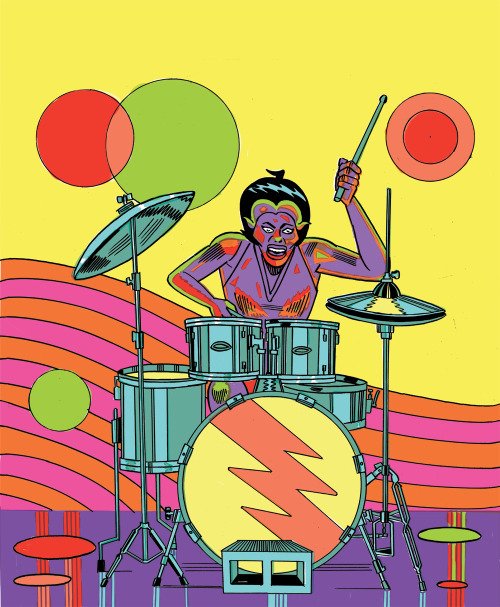
AD: My whole life, I’ve always wanted to champion art making and creative pursuits that weren’t getting a lot of recognition or weren’t getting their creators a lot of money. I think I wanted to be antagonistic. I wanted them to play a type of music that wasn’t popular, and that wasn’t going to make them popular. I knew they were going to be struggling with questions about their day jobs. I wanted it to not have any resolutions for them, they were not gonna become famous playing this type of music. They were never going to be suddenly picked up by a big label and become successful like in the movies. The lives of musicians as portrayed in the media are either tragedies or rags-to-riches stories; someone’s struggling and then they get a big break. I knew my characters were never gonna get a break, so by picking that genre of music, I was closing that narrative avenue. That’s why I picked an unpopular type of music for the book.
PL: And was picking Chicago inspired by the same reasoning?
AD: In a way, yes. Picking Chicago was antagonistic. It’s not New York or L.A. But it’s where I live and I love it here.
The comics community is so fragmented. There are literary comics, there’s these gross-out guys comics about balls getting ripped off, there’s indie comics, there’s a manga crowd and it starts to feel really torn as to who your audience is, and who it could be. I would like to appeal broadly and do something that is universally enjoyable, but I’m not interested in making something that is just candy, something that people want to eat up with no substance. First of all, I’m not a good enough draftsman to make something that only looks good but isn’t smart. Some people can afford to make a purely aesthetic comic with no substance, but I’m not good enough to pull that off so it’s not an option. With Band for Life, if you like it, you like it, if you get it, you get it. If you agree with me, awesome. It’s about a noise rock band in Chicago. If you don’t think rock music is cool and if you think Chicago is a terrible city, maybe it isn’t for you or maybe it is in spite of all of that.
PL: You can still derive some universal truth when looking at something specific too. I don’t think you’re too far off the mark.
AD: I believe in that wholeheartedly. I think it’s one of the most important tips I’d give to a fiction writer: you can find universality in the specific. I hope that Band for Life does that. I hope people who don’t like music or who don’t live in Chicago can enjoy it and find things about the creative experience and the human experience that they can relate to. It feels almost contradictory, in a way, I don’t care about making something appealing, but I still hope that my work, with all of it’s flaws and quirks, is appealing and relatable.
PL: Speaking of universality and the human experience, does Band for Life, and to a certain extent your comic book output help you make sense of the world, or at least more of it than you did before you started creating it?
AD: Absolutely, For one thing I’m really interested in dialogue, in verbal interaction and how to convey this in comics. I think first and foremost, Band for Life is a work of humour. I embellished it in some ways to make it funny, but a lot of the conversations are almost word for word conversations that I’ve had with people. I address issues in the book that were worrying me and my friends that we would constantly go back to in our interactions. There’s a lot of references to vegetarianism, and veganism, lots of contemporary issues that were sort of exploding at the time I was writing the book, like police brutality. It makes me wonder if my work is too preachy. If my work is too preachy, will it be an entertaining read? I felt it was important to address these issues in my work, to take the basis of dialogue and conversations I’ve had and let others explore it further. I feel I’d betray myself if I didn’t.
I almost feel annoyed that I set this story in a parallel universe. All my characters are, well, humans really, but they’re depicted as monsters. I found myself thinking it was hard to address police brutality and real life issues in the book. You’re meant to think that those characters look outrageous, but they’re really people. I think that’s why with Retrofit, I just want to do people. It’s harder and harder to integrate humour and real life issues efficiently when everyone looks like a monster. I hope I pulled it off in the book.
The interesting thing with Band for Life was that, because it was serialized online, I was receiving feedback as I went along. With School Spirits, I had no feedback at all and no one read it until it was finished. I think people understand that Band for Life is essentially a comic about the real world, but with hideous-looking monsters.
PL: You’ve previously published work both in colour (Believed Behavior) and in black and white (School Spirits). How do you approach making a comic book in colour and is that approach different for a work in black and white?
AD: The approach is quite different with colour. You can do a lot of form and volume that you can’t do in black and white, or at least that I can’t do in black and white. Better artists than me, like Mike Mignola and the Hernandez brothers, can do it. When I draw something I know will be coloured, I change my approach. I don’t do as many flat blacks, I don’t do as much hatching. I draw it more sparsely, because I know my colours will come in and bring an extra depth later. With black and white, you have to make the depth with value. I draw differently basically.
With colour though, I feel like I’m a late bloomer and I’ll probably always be learning my craft. I’ve done all kinds of different colouring techniques. I’m trying to find out what’s best. I’ve done flat colour in Photoshop before, but mostly I like coloured pencils, markers and paints. I feel the Photoshop colour looks too flat and I wanted something that looked a little more naturalistic and had more depth. Marker colour is cool because you can work really quickly. It prints okay, but I think paint prints better. I have yet to see how coloured pencil prints. I don’t know how that’s going to look. I enjoy colouring by hand a lot more than I do colouring in photoshop. I don’t like staring at a computer screen.
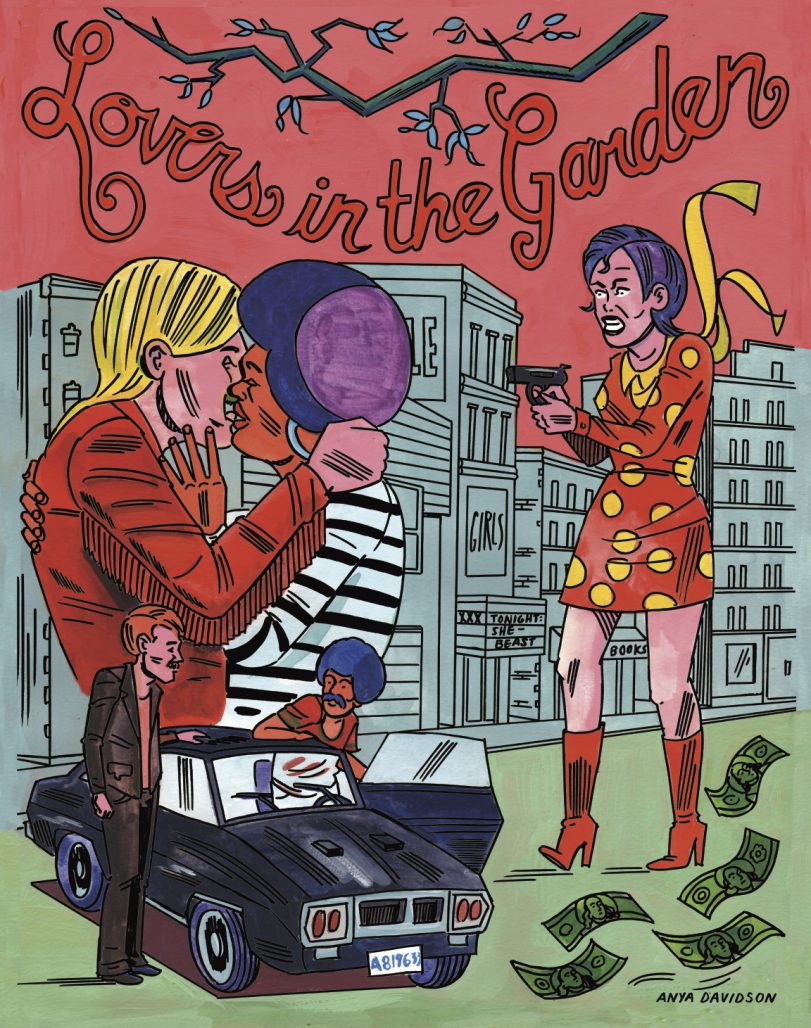
AD: I did for the cover of Lovers in the Garden, my brand new comic. It’s hard to say how it turned out, I didn’t see how that looks printed. The inside of the book is all done with a combination of coloured pencils and markers and the cover is gouache. But I haven’t seen the final prints yet, so I don’t know. The marker colours look very light on a computer screen and it looks darker printed. I’m curious to see how the gouache will look. I don’t know. I’m still learning. I’ve just done a story for an anthology that Breakdown Press is releasing and I coloured that in Photoshop.
Every method has it’s advantages and disadvantages. Nothing is without hassle, it’s all difficult and therefore you have to do the thing that you enjoy the most because life is short. You have to enjoy your work. In cartoons more than anything because it’s so time consuming. If you like colouring something with coloured pencil, do it. Julie Delporte and Eleanor Davis do it and it looks amazing.
Lorrenzo Mattotti’s work looks incredible too. I don’t know how he does it, how he scans it or any of his tricks to brighten up the pages. I’m learning and developing some tricks, but a lot is from looking at other artists and seeing what they’re doing and thinking “damn this looks amazing, I want to try something like that” and then playing around with the material and finding what feels right.
Part of me thinks I’m too old to keep experimenting and I should be finding one thing and get really good at it. I was reading about this famous portrait photographer, Gertrude Käsebier, around the turn of the century and she didn’t start Art School until she was 37, with 3 kids and a domineering husband and she went on to become one of the most famous photographers in America. It’s inspiring.
PL: Now that Band for Life is going to be released soon, what’s next for you? Can you tell us more about your upcoming projects? You mentioned a new comic that will be published by Retrofit Comics. Is there any exciting project coming soon?
AD: There’s a biographical project I’m working on, but I don’t want to talk too much about it now. I’m kind of superstitious and I feel like it’s really important to do stuff rather than talk about it. I’m in the research stuff right now. It’s about an artist from the early 1900’s who’s been forgotten and I’m researching her right now. I don’t want to say more until I draw the first page, I don’t want to jinx it. Before I start blabbing about I want to have a chapter done at least. It’s been hard because there hasn’t been a lot written about her, so I have to keep digging. It’s going to be a labour of love.
PL: What would you recommend we listen to as we’re reading the book?
AD: I could list off bands all day. When I first moved to Chicago at eighteen, I was only really familiar with punk and hardcore. I loved soul music too. My friends in Chicago turned me onto world music, noise music, early industrial stuff, obscure psych stuff from the ‘70’s. Stockhausen is a great composer people should look into. He’s a precursor to industrial music. He was doing composition with objects and non-traditional musical instruments. God is My Copilot and Scissor Girls are two Chicago noise rock bands I really love. There are women in both these groups which is important to me. The Jesus Lizard for sure. There’s a music label called Amphetamine Reptile that had a lot of really abrasive noise rock bands on it. Today is the Day was one of those good bands. Black Widow is a pagan folk band from the 70’s I’d recommend. I listen to a lot of Parliament-Funkadelics, I love all their albums but Maggot Brain and Take it to the Stage are two amazing albums. Betty Davis is an incredible singer. Hawkwind I love. Sir Lord Baltimore, Atomic Rooster.
As I got older I realized that there’s no right way to be a creative person. I’m glad I moved past my narrow punk and hardcore phase, because now I can enjoy Tuvan throat singing and Indonesian Gamelan music and I’ve had tons of experiences I wouldn’t have had if I’d been locked into one particular subculture.
– –
Band for Life is published by Fantagraphics and is available. You can order the book Here


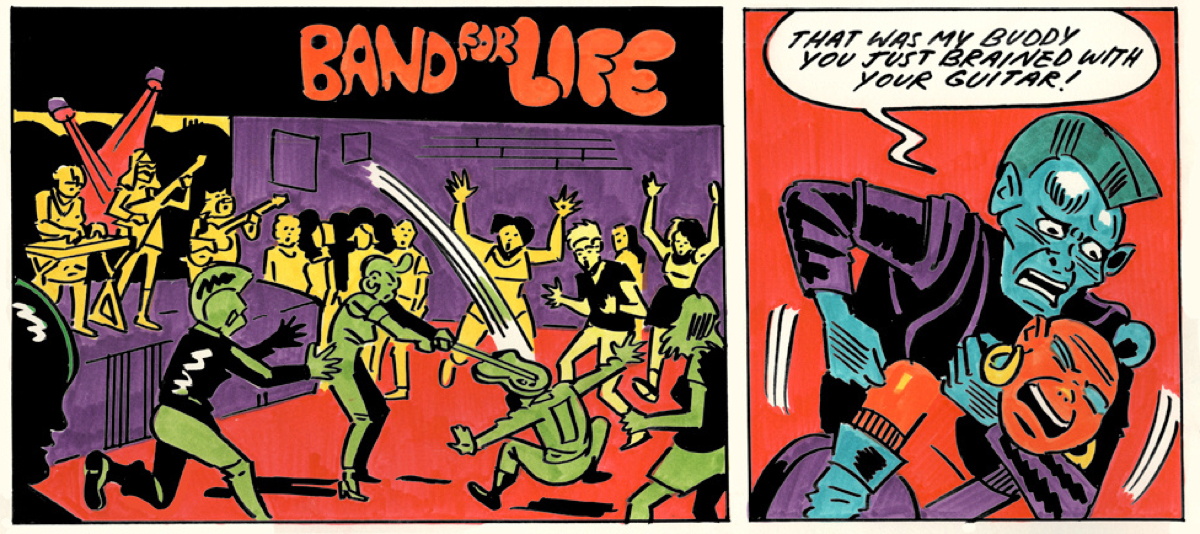
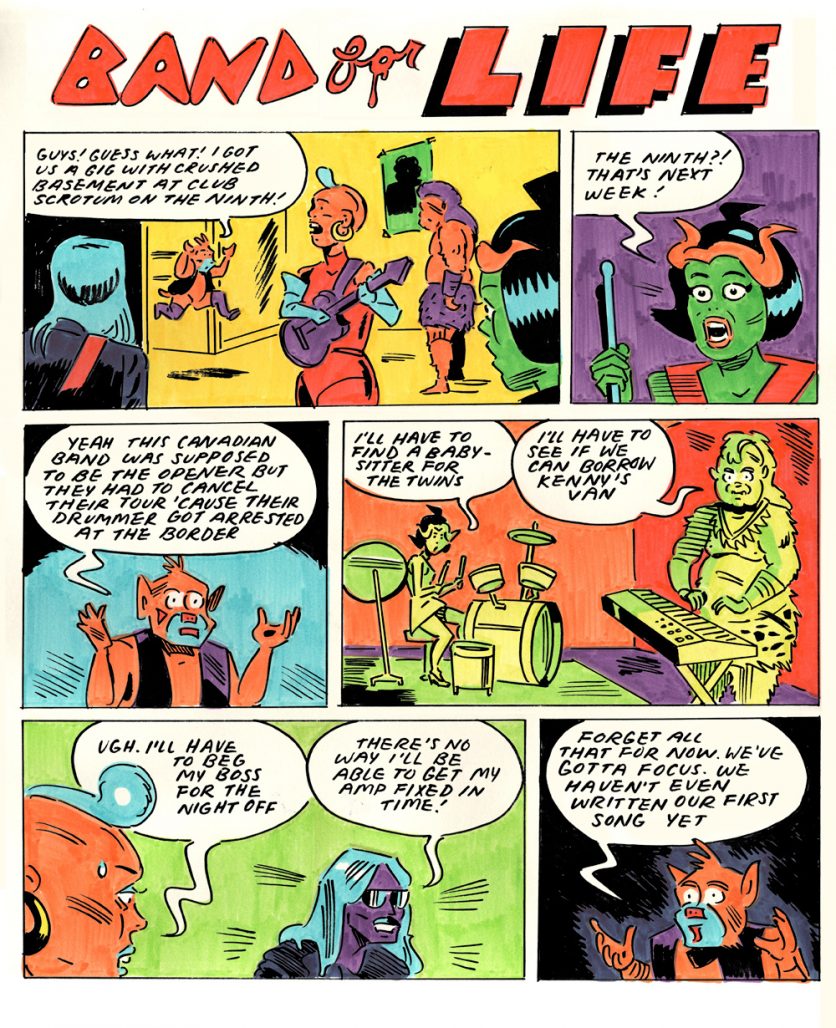
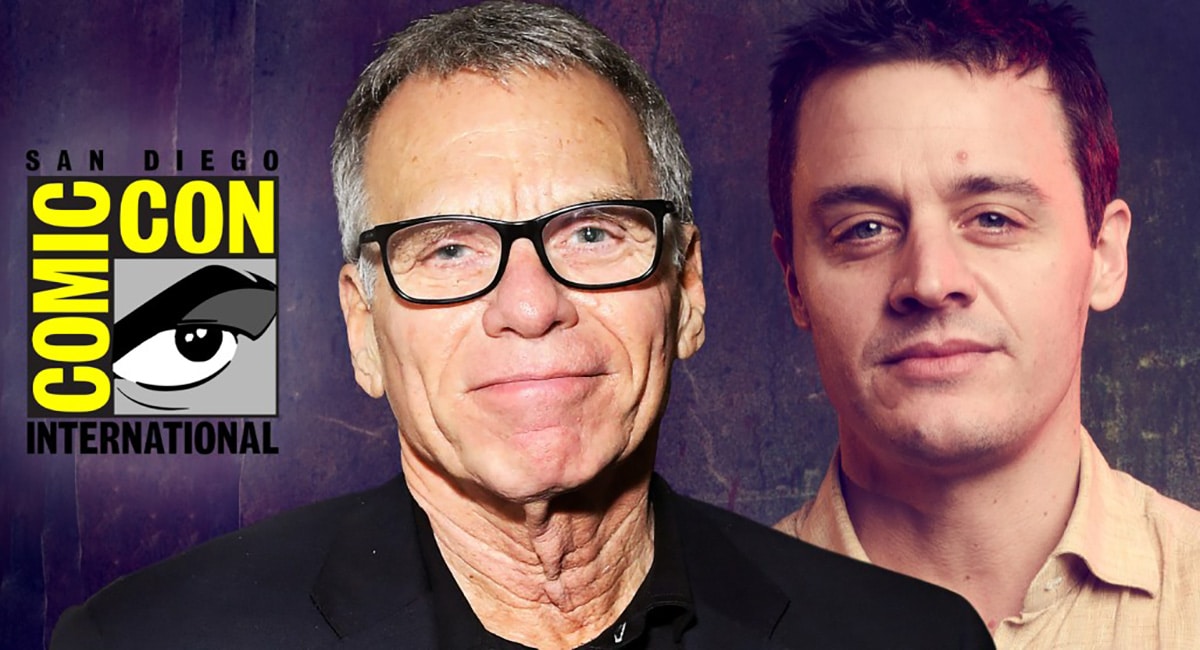





Comments are closed.